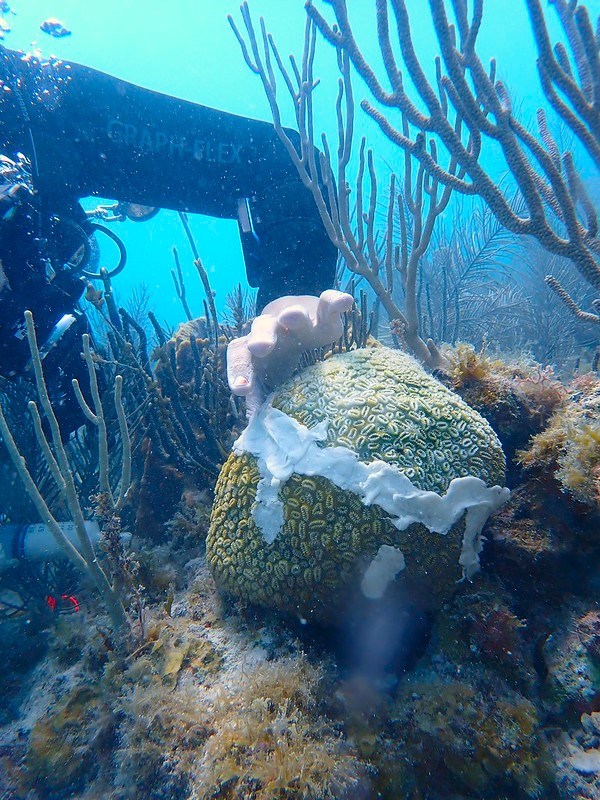Last updated: April 22, 2024
Article
National Park Service Protects Critical Corals from Destructive Disease

NPS / Shaun Wolfe
“Coral reefs are an incredibly important ecosystem, but they are in critical danger,” said Anna Toline, a National Park Service (NPS) marine ecologist focused on corals in ocean parks of the southeast United States including the Caribbean.
“Live coral cover in southeastern parks has declined by as much as 90 percent at some sites in the last 30 years.”
There are myriad threats to corals including disease, overfishing, vessel groundings, reductions in water quality, physical and chemical damage caused by ocean debris, and the consequences of climate-driven rising sea temperatures.
It is difficult to stand on the shoreline and see the damage to coral reef ecosystems that ocean scientists have documented in the past 20 years. But there is an image to which we can relate – wildfire. “People can see and connect with the loss from wildfires because the damage is so obvious on land.” Toline said.
One of the greatest threats to coral is disease and one of the deadliest of the multiple diseases that affect corals is Stony Coral Tissue Loss Disease. Discovered in the Caribbean in 2019, it is one of the most devastating impacts to coral in the history of the region. It can lead to whole colony mortality in just three weeks. Without intervention, stony coral reefs could be lost to the disease. It has led to severe coral loss at all six parks in the region that manage coral reefs.

NOAA / Leslie Henderson
There is hope, though. Teams of scientists are at work on projects to save coral reefs and working to build their capacity to protect the millions of species that live primarily on or exclusively in association with them. Several of these projects, which are part of the overall NPS coral management strategy, are possible because of funding from the Bipartisan Infrastructure Law and the Inflation Reduction Act.
One of the treatments to halt Stony Coral Tissue Loss Disease is the application of a paste laden with the antibiotic amoxicillin to lesions on corals caused by the disease. The treatment halts the progression of the disease and can effectively save as much as 85 percent of infected corals.
This project will enable the use of antibiotic treatments to minimize damage from this disease to reefs considered most ecologically valuable, targeted for restoration from hurricane impacts, and valuable to visitor experience. The treatments will be applied to 25 species of coral at all six parks that manage coral reefs in the Southeast Region – Buck Island Reef National Monument, Salt River Bay National Historical Park & Ecological Preserve, Virgin Islands National Park, and Virgin Islands Coral Reef National Monument, Biscayne National Park, Dry Tortugas National Park. Parks, such as Buck Island Reef, and partner organizations have created volunteer programs and Strike Teams to locate and treat corals with the disease.

NPS / Kristen Ewen
Protecting corals from disease and restoring corals will require a long-term commitment and the continued dedication of universities, non-governmental organizations, volunteers, and territorial, state, and federal partners. Research is underway to investigate alternative, including preventive, treatments such as the use of probiotics and finding corals resistant to the disease.
Additional restoration projects will utilize in-water and land-based nurseries, staff, and the best available science and coral restoration expertise to outplant coral back onto the reef at up to five sites identified by each of these Caribbean parks. Implementation of this project will allow for the preservation of selected reefs and the prevention of extirpation of multiple species at these parks.

NPS / Rachel Johns
Restoration and research projects in parks will also help protect coral reef ecosystems and the benefits they contribute to people, plants, animals, and our shared environment. Projects include:
- Biscayne National Park - Genotyping elkhorn coral, propagation of coral larvae, and Scientist in Parks (SIP) interns for treating diseased corals.
- Dry Tortugas National Park – Site assessments to provide direction to treatment and restoration efforts and assistance for implementation of restoration and treatment efforts.
- Virgin Islands National Park – Outplanting coral for restoration.
- Virgin Islands Coral Reef National Monument – Treating coral disease.
- Buck Island Reef National Monument – Outplanting coral for restoration.
- Salt River Bay National Historical Park and Ecological Preserve – Treating coral disease.
Restoration and attacking disease with antibiotics are part of the solution to coral loss. However, Toline said, “We need to protect what we have by taking additional actions such as reducing marine debris, improving water quality, and preventing additional physical damage.”
Tags
- biscayne national park
- buck island reef national monument
- dry tortugas national park
- salt river bay national historical park and ecological preserve
- virgin islands national park
- virgin islands coral reef national monument
- inflation reduction act
- bipartisan infrastructure law
- ecosystem restoration
- coral reefs
